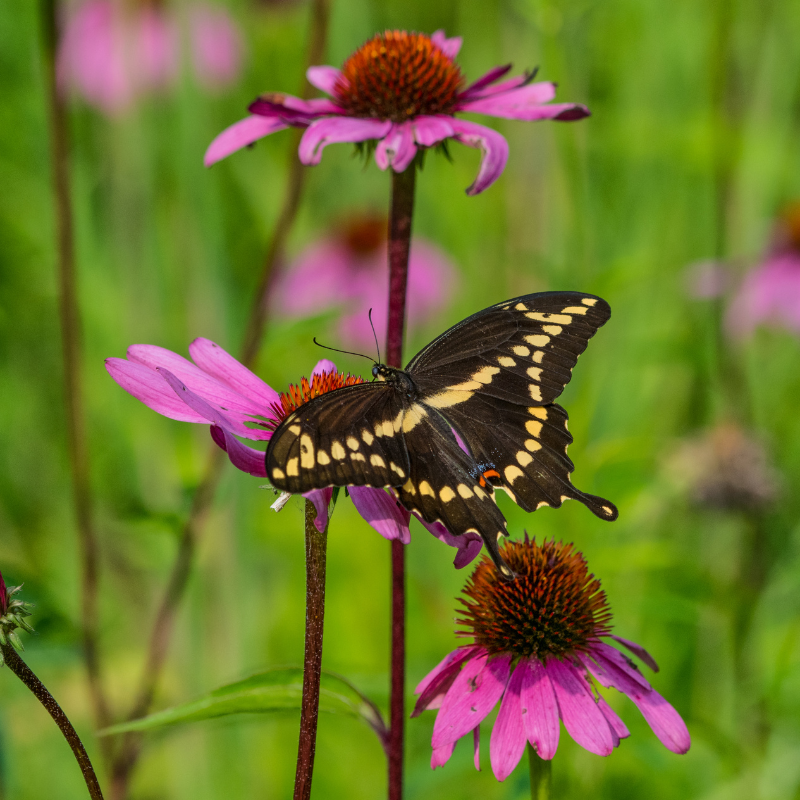There’s a plant in my garden called Buddleia. Its common name is Butterfly Bush, and it lives up to that name because, once its flowers come out, butterflies (and certain moths) swarm to it. I live in a place with cold winters, and I used to have to re-plant it every year. Because our winters have gotten warmer, this spring, I noticed the one I planted last year had re-sprouted.

I love growing perennials in my garden. Unlike annuals, which last one season, perennials re-appear each spring. When they do, it’s like seeing an old, familiar friend, one I’ve missed and am always glad to see. It’s also a lesson in the resilience of nature. Because I, just like you, am part of nature, it’s a welcome reminder of my own resilience, something I, just like you, can forget from time to time.
Of all the winged visitors that have graced the butterfly bushes I’ve planted over the years, one stands out in my mind, because some years ago, the first time I saw it, I’d completely forgotten that resilience was something I was born with, just like you were. I had a severe case of Lyme disease. My whole body hurt, my brain was in a fog, my mood was low, and I felt desperate, convinced that my health had completely abandoned me. In other words, a perfect combination of factors conspiring to create the illusion that resilience was foreign to me.
That particular summer was especially hot. One day in August, after the Butterfly Bush had started blooming, I was staring at it from my porch when a visitor I’d never seen before lighted on it. It was the biggest non-tropical butterfly I’d ever seen; a brown so dark it looked black, with yellow stripes. It’s called a Giant Swallowtail, and is fairly rare around where I live. It’s a dramatic creature, and I found I couldn’t look away from it. I know it was a female, because the females of that species are bigger than the males.
By big, I mean five-and-a-half inches, wingtip to wingtip.
A Giant Swallowtail is so big, and the proportion of wing to the body so out of scale that, unlike other butterflies, it has difficulty resting on a flower with its wings open. If it doesn’t keep its wings moving, it risks falling to the ground. This one had an additional disadvantage. It looked like it had escaped being eaten by a bird. Both the left and right primary wings had chunks missing.

Any butterfly is a miracle, but Giant Swallowtails seem especially miraculous to me. That first one I saw was even more miraculous because, despite the injury to it, it just kept going, flapping its wings, taking in pollen with its long tongue. That beautiful, delicate, injured butterfly was like a messenger sent directly to me, and the message it carried was crystal clear: I may be physically compromised, but look how I just keep going. You can do the same thing. You were born to be resilient, just like I was.
I remember doing a lot of staring that summer. I’ve discovered that, instead of being a waste of time, when I come out of a good stare, I feel like my brain has been re-booted, and I can see the world through fresh eyes. That’s because my mind slows down to the speed of life when I’m staring at something. Of all the things I stared at that summer, none made a stronger impression than the message the butterfly brought me.
I’m made of life. Life is resilient, which means I’m resilient.
That was fifteen years ago. I still navigate the long-term effects of Lyme Disease, but I never lose sight of the message that Giant Swallowtail brought me. I just keep going without any need or impulse to complain. I’m hoping to see a Giant Swallowtail this August, so I can thank it for the grace-filled message its ancestor brought me.
If you would like to know when The Slightly Older Person’s Guide to Graceful Aging comes out, please click here to put your name on the list. To read my other articles, click here.




